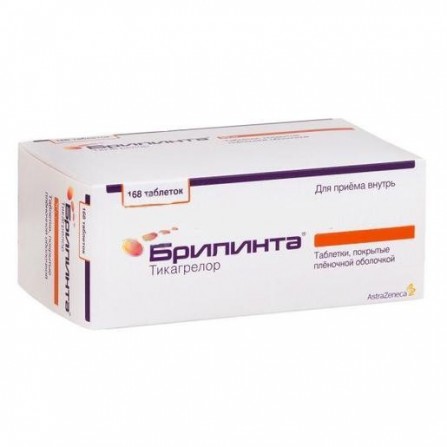Brilinta pills 60 mg 168 pcs
Condition: New product
1000 Items
Rating:
Be the first to write a review!

More info
Description
Brillinta pills are necessary for the treatment of cardiovascular diseases. The drug belongs to antiplatelet agents and reduces the risk of blood clots that can lead to brain stroke or myocardial infarction.
Active ingredients
Ticagrelor
Release form
Pills
Composition
Ticagrelor, mannitol, calcium phosphate, sodium carboxymethyl starch, hyprolosis, magnesium stearate, tablet shell: hypromellose, titanium dioxide (E 171), macrogol 400, black iron oxide dye, red iron oxide dye.
Pharmacological effect
Brilinta contains ticagrelor, a member of the chemical class of cyclopentyl triazolopyrimidines, which is a selective and reversible antagonist of the P2Y12 receptor to ADP and can prevent ADP-mediated platelet activation and aggregation. Ticagrelor is active when ingested and reversibly interacts with the P2Y12-ADP platelet receptor. Ticagrelor does not interact with the site of binding of ADP itself, but its interaction with the P2Y12 receptor of platelets to ADP prevents signal transduction.
Pharmacokinetics
Ticagrelor demonstrates linear pharmacokinetics, and exposure to ticagrelor and active metabolite (AR-C124910XX) is approximately proportional to doses up to 1260 mg. It is absorbed with an average Tmax of about 1.5 hours. The average absolute bioavailability of ticagrelor is 36%. Eating fat does not affect the Cmax of ticagrelor or the AUC of the active metabolite, but results in an increase of 21% in the AUC of ticagrelor and a decrease of 22% in the Cmax of the active metabolite. These small changes have minimal clinical significance, so ticagrelor can be prescribed regardless of the meal. Ticagrelor and the active metabolite are actively associated with plasma proteins (> 99%). The main route of elimination of ticagrelor is through hepatic metabolism. In general, the active metabolite is excreted in the bile. The average T1 / 2 of ticagrelor and active metabolite was 7 and 8.5 h, respectively.
Indications
Appointment simultaneously with acetylsalicylic acid, is indicated for the prevention of atherothrombotic complications in adult patients with a myocardial infarction in history (myocardial infarction was postponed one year or more ago) and a high risk of developing atherothrombotic complication.
Contraindications
Hypersensitivity to Ticagrelor or auxiliary substance any drug active abnormal bleeding, intracranial bleeding history, liver dysfunction, severe, combined use with ticagrelor potent inhibitors isoenzyme CYP3A4 (e.g., ketoconazole, clarithromycin, nefazodone, ritonavir and atazanavir).
Precautionary measures
Precautions: if the patient is susceptible to the development of bleeding, with abnormal liver functions of moderate severity, with the risk of developing bradycardia, with bronchial asthma and / or chronic obstructive pulmonary disease (COPD) in the anamnesis.
Use during pregnancy and lactation
Not recommended
Dosage and administration
Reception inside. Does not depend on food intake. If swallowing is difficult, Brilint's tablet should be crushed to a powder, mixed in 1/2 cup of drinking water and immediately drink the resulting suspension. Mix residues with an additional 1/2 cup of drinking water and also drink. The recommended dose for patients with a myocardial infarction history (one year or more ago) is 60 mg twice a day. When taking Brilinta, you need to take a daily low maintenance dose of ASA (75-150 mg), if there are no specific contraindications. Long-term therapy is recommended. Premature cancellation may increase the risk of cardiovascular death or myocardial infarction as a result of the underlying disease. You should also avoid interruptions in therapy. A patient who misses taking Brillinta should take only one 60 mg tablet (next dose) at the scheduled time. When transferring patients to Brillinta, the first dose should be administered 24 hours after taking the last dose of another antiplatelet drug.
Side effects
Hyperuricemia, intracranial hemorrhage, dizziness, hemorrhage (intraocular, conjunctival, retinal), bleeding in the ear, Vertigo, dyspnea, epistaxis, gastritis, emesis with blood, bleeding ulcer in the stomach, vomiting, diarrhea, dyspepsia, hemarthrosis, hemorrhage urinary ways.
Overdose
Ticagrelor is well tolerated in a single dose of the drug up to 900 mg. As the dose was increased, the adverse effect on the gastrointestinal tract was dose-limiting.Other possible reactions to overdose are shortness of breath and ventricular pauses. In case of overdose, symptomatic therapy should be carried out in accordance with local standards.
Interaction with other drugs
The combined use of ketoconazole with ticagrelor increases the Cmax and AUC of ticagrelor 2.4 and 7.3 times, respectively. The Cmax and AUC of the active metabolite decrease by 89% and 56%, respectively. Other potent inhibitors of CYP3A4 (clarithromycin, nefazodone, ritonavir, and atazanavir) will have the same effects; therefore, the combined use of potent inhibitors of CYP3A4 with Brillinta is contraindicated. The combined use of ticagrelor with powerful inducers of CYP3A can reduce the exposure and efficacy of ticagrelor, therefore, their use with Brillinta should be avoided. Combined use of simvastatin at a dose above 40 mg / day. with ticagrelor can lead to the development of side effects of simvastatin, and it is necessary to evaluate the balance of potential risk and benefit. Tikagrelor may have a similar effect on lovastatin. The combined use of ticagrelor with simvastatin or lovastatin in a dose of over 40 mg is not recommended. The combined use of ticagrelor and CYP3A4 isoenzyme substrates with a narrow therapeutic index (for example, cisapride or ergot alkaloids) is not recommended, since ticagrelor can increase the exposure of these drugs.
special instructions
Before the planned operation or the start of taking new drugs, the patient should be informed by the doctor that he is taking Brillint.


